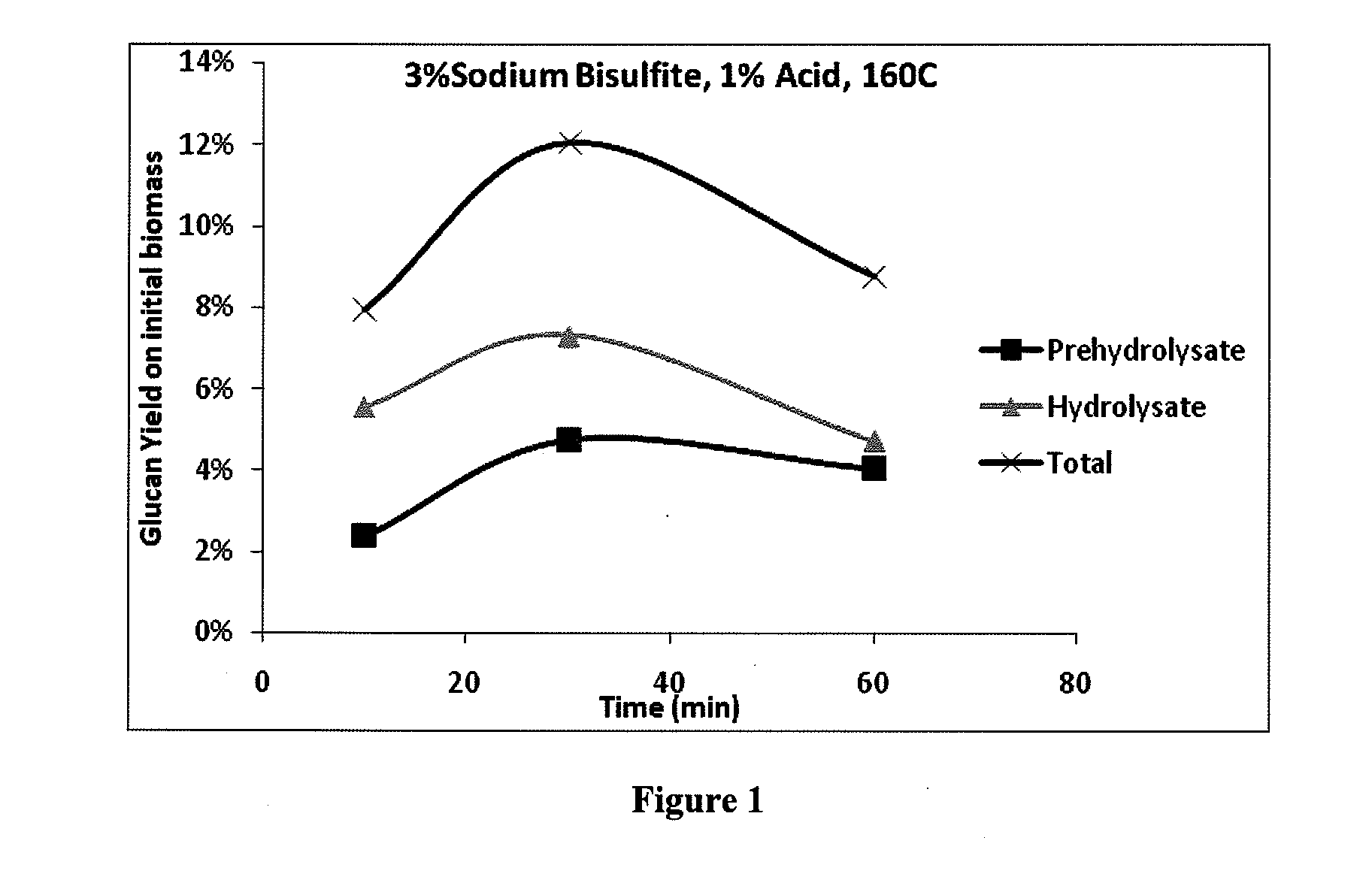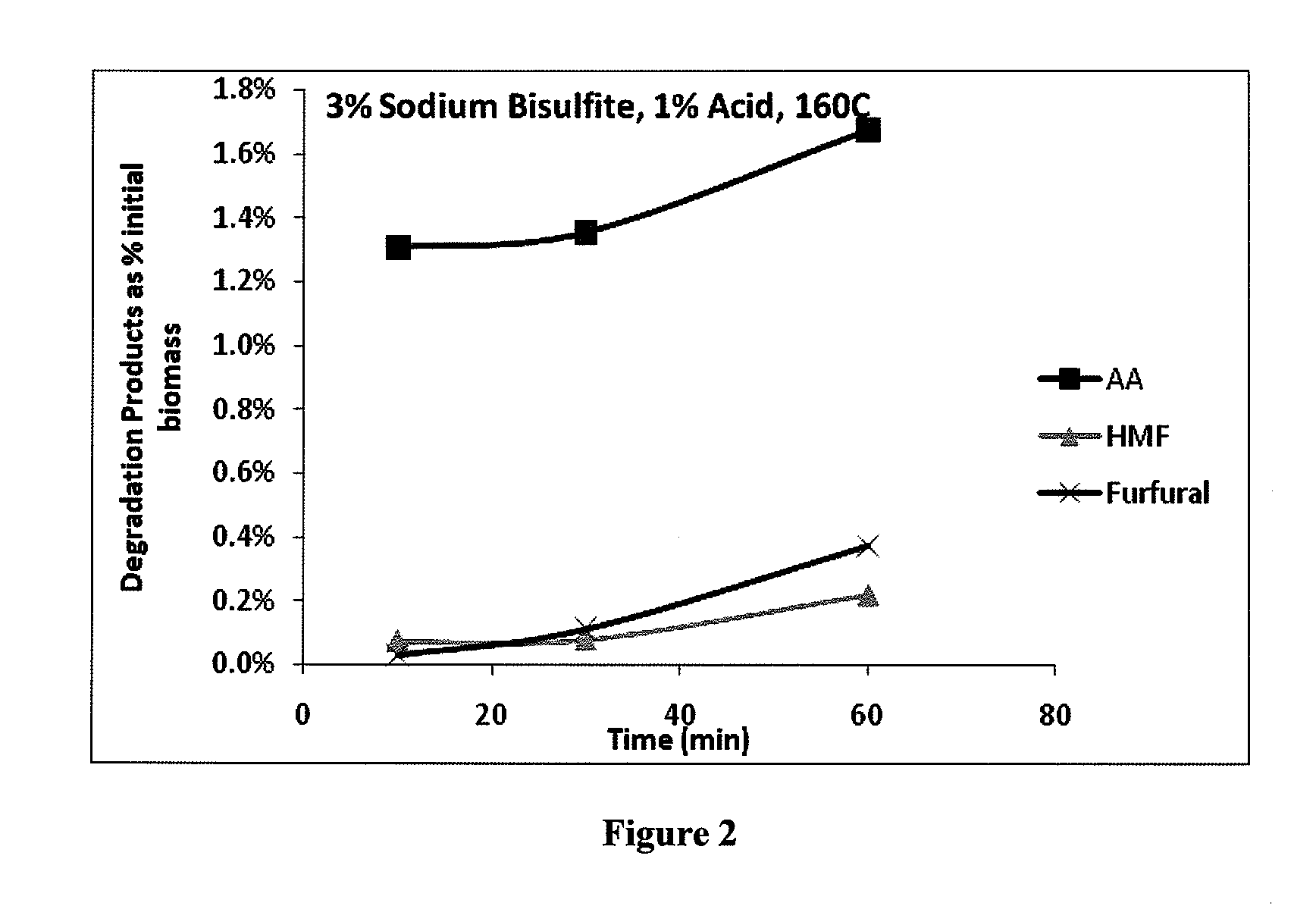Pretreatment of Ligno-Cellulosic Biomass with Sulfonation
a technology of lignocellulosic biomass and sulfonation, which is applied in the direction of pulping with acid salts/anhydrides, pulp by-product recovery, and production of hmf and furfural in particular, can solve the problems of limiting the amount of hydrolysis, and affecting the yield of sugar, so as to reduce the cost and complexity of the overall process , the effect of high sugar yield
- Summary
- Abstract
- Description
- Claims
- Application Information
AI Technical Summary
Benefits of technology
Problems solved by technology
Method used
Image
Examples
example 1
Results on Softwoods (Pine Harvest Residuals)
[0082]One method of eliminating exogenous acid is to amplify the benefits of sulfonation by controlling the selectivity of degradation reactions compared to the sulfonation reaction. For example, pine harvest residuals were subjected to acid hydrolysis at a 6:1 liquor to wood ratio and 1% acid on wood with the following results at 160° C. As shown in FIG. 1, the solubilized glucan in the prehydrolysate begins to decrease at some point around 30 minutes. This may be due to degradation of glucose and is accompanied by an increase in degradation products, as shown in FIG. 2. FIGS. 3 and 4 show the same effect occurring even at 7% sodium bisulfite concentration. The glucan in the hydrolysate is higher at 7% sodium bisulfite because the sulfonation of the lignin enables enzymes to be used more efficiently, but the rate of formation of degradation products is similar.
[0083]The degradation rates would be lower if acid were decreased. The methods...
example 2
Results on Hardwoods (Early Cleanings and Poplar)
[0087]Two hardwood samples were hydrolyzed with this method: poplar and an understory harvest from the southeastern U.S. (“Early Cleanings”) that showed almost entirely hardwood fibers upon fiber analysis. Both furnishes were treated without added acid with 7% ammonium bisulfite on wood for 30 minutes at 160° C. followed immediately by 60 minutes at 145° C. Table 1 shows the results. The non-acid condition for Early Cleanings has an especially good hydrolysis yield of approximately 72%.
TABLE 1Hardwood examples of the total hydrolysis and the prehydrolysatecontent with 7% ammonium bisulfite and two-step temperatureregime 160° C. 30 min. / 145° C. 60 min. All data expressed aspercentage of initial biomass.% Acid% Total% HMF in% Furfural inFeedstockAddedHydrolysisprehydrolysateprehydrolysateEarly071.70.00.1CleaningsEarly133.40.00.0CleaningsPoplar063.90.00.0
example 3
Results on Switchgrass
[0088]The same conditions as in Table 1 were run for switchgrass, with both 1% acid on switchgrass and no acid. Preliminary results show solubilization was 5% and 7% for 0% and 1% acid, respectively, and the total amount of hydrolysis was 8% and 23%, respectively. Hydrolysis yields may improve with further optimization.
PUM
| Property | Measurement | Unit |
|---|---|---|
| temperature | aaaaa | aaaaa |
| temperature | aaaaa | aaaaa |
| temperature | aaaaa | aaaaa |
Abstract
Description
Claims
Application Information
 Login to View More
Login to View More - R&D
- Intellectual Property
- Life Sciences
- Materials
- Tech Scout
- Unparalleled Data Quality
- Higher Quality Content
- 60% Fewer Hallucinations
Browse by: Latest US Patents, China's latest patents, Technical Efficacy Thesaurus, Application Domain, Technology Topic, Popular Technical Reports.
© 2025 PatSnap. All rights reserved.Legal|Privacy policy|Modern Slavery Act Transparency Statement|Sitemap|About US| Contact US: help@patsnap.com



